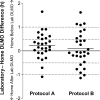Home Circadian Phase Assessments with Measures of Compliance Yield Accurate Dim Light Melatonin Onsets
- PMID: 25409110
- PMCID: PMC4434555
- DOI: 10.5665/sleep.4734
Home Circadian Phase Assessments with Measures of Compliance Yield Accurate Dim Light Melatonin Onsets
Abstract
Study objectives: There is a need for the accurate assessment of circadian phase outside of the clinic/laboratory, particularly with the gold standard dim light melatonin onset (DLMO). We tested a novel kit designed to assist in saliva sampling at home for later determination of the DLMO. The home kit includes objective measures of compliance to the requirements for dim light and half-hourly saliva sampling.
Design: Participants were randomized to one of two 10-day protocols. Each protocol consisted of two back-to-back home and laboratory phase assessments in counterbalanced order, separated by a 5-day break.
Setting: Laboratory or participants' homes.
Participants: Thirty-five healthy adults, age 21-62 y.
Interventions: N/A.
Measurements and results: Most participants received at least one 30-sec epoch of light > 50 lux during the home phase assessments (average light intensity 4.5 lux), but on average for < 9 min of the required 8.5 h. Most participants collected every saliva sample within 5 min of the scheduled time. Ninety-two percent of home DLMOs were not affected by light > 50 lux or sampling errors. There was no significant difference between the home and laboratory DLMOs (P > 0.05); on average the home DLMOs occurred 9.6 min before the laboratory DLMOs. The home DLMOs were highly correlated with the laboratory DLMOs (r = 0.91, P < 0.001).
Conclusions: Participants were reasonably compliant to the home phase assessment procedures. The good agreement between the home and laboratory dim light melatonin onsets (DLMOs) demonstrates that including objective measures of light exposure and sample timing during home saliva sampling can lead to accurate home DLMOs.
Clinical trial registration: Circadian Phase Assessments at Home, http://clinicaltrials.gov/show/NCT01487252, NCT01487252.
Keywords: circadian; compliance; light; melatonin.
© 2015 Associated Professional Sleep Societies, LLC.
Figures




Comment in
-
Are We Ready to Assess Circadian Phase at Home?Sleep. 2015 Jun 1;38(6):849-50. doi: 10.5665/sleep.4722. Sleep. 2015. PMID: 26039960 Free PMC article. No abstract available.
References
-
- Lewy AJ, Cutler NL, Sack RL. The endogenous melatonin profile as a marker of circadian phase position. J Biol Rhythms. 1999;14:227–36. - PubMed
-
- Klerman EB, Gershengorn HB, Duffy JF, Kronauer RE. Comparisons of the variability of three markers of the human circadian pacemaker. J Biol Rhythms. 2002;17:181–93. - PubMed
-
- Lewy AJ, Wehr TA, Goodwin FK, Newsome DA, Markey SP. Light suppresses melatonin secretion in humans. Science. 1980;210:1267–9. - PubMed
-
- American Academy of Sleep Medicine. The International Classification of Sleep Disorders. 3rd Edition. Darien, IL: American Academy of Sleep Medicine; 2014. - PubMed
Publication types
MeSH terms
Substances
Associated data
Grants and funding
LinkOut - more resources
Full Text Sources
Other Literature Sources
Medical

